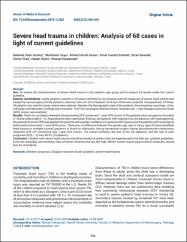| dc.contributor.author | Gürbüz, Mehmet Sabri | |
| dc.contributor.author | Duyu, Muhterem | |
| dc.contributor.author | Gezen, Ahmet Ferruh | |
| dc.contributor.author | Canızcı Erdemli, Pınar | |
| dc.contributor.author | Boşnak, Ercan | |
| dc.contributor.author | Elias, Çimen | |
| dc.contributor.author | Karaarslan, Numan | |
| dc.date.accessioned | 2022-05-11T14:34:45Z | |
| dc.date.available | 2022-05-11T14:34:45Z | |
| dc.date.issued | 2020 | |
| dc.identifier.issn | 2636-7688 | |
| dc.identifier.issn | 2636-7688 | |
| dc.identifier.uri | https://doi.org/10.5455/annalsmedres.2019.12.822 | |
| dc.identifier.uri | https://app.trdizin.gov.tr/makale/TXpZMU5ETXdNQT09 | |
| dc.identifier.uri | https://hdl.handle.net/20.500.11776/8076 | |
| dc.description.abstract | Aim: To assess the characteristics of severe head trauma in the pediatric age group and to analyze its results under the currentguideline.Material and Methods: Eighty pediatric patients (<18 years) admitted to our hospital with the diagnosis of severe head trauma andtreated by neurosurgery and the pediatric intensive care unit (ICU) between 2014 and 2018 were analyzed retrospectively. Of these,68 patients who met the study criteria were selected. Besides the demographic data of the patients, the presenting neurologic, clinic,radiologic and laboratory findings were recorded. Then the association between these variables and 1-year Glasgow Outcome Scale(GOS) scores was analyzed.Results: There is a correlation between the presenting GCS scores and 1-year GOS scores of the patients when grouped as favorable(4-5) and unfavorable (1-3). Regarding the other admission findings, the patients with hypothermia, the patients with hyperglycemia,the patients to whom CPR was applied, the patients with pupillary areflexia, the patients with hypoxia and the patients with neurologicaldeterioration have lower 1-year GOS scores. There was no difference between the gender, age, type of injury, type of trauma (isolatedhead trauma or multiple trauma), presence of shock on admission, having hematoma surgery, having decompressive craniectomy,treatment with ICP monitoring and 1-year GOS scores. The overall mortality rate was 29.4% (20 patients), and the rate of poorprognosis (GOS 1-3) was 48.5% (33 patients).Conclusion: Children with severe head trauma should be treated at centers that are experienced in the field per updated guidelines.Since the morbidity and mortality rates of severe head trauma are still high, efforts toward improving preventive measures shouldalso be considered. | en_US |
| dc.language.iso | eng | en_US |
| dc.identifier.doi | 10.5455/annalsmedres.2019.12.822 | |
| dc.rights | info:eu-repo/semantics/openAccess | en_US |
| dc.title | Severe head trauma in children: Analysis of 68 cases in light of current guidelines | en_US |
| dc.type | article | en_US |
| dc.relation.ispartof | Annals of Medical Research | en_US |
| dc.department | Fakülteler, Tıp Fakültesi, Cerrahi Tıp Bilimleri Bölümü, Beyin ve Sinir Cerrahisi Ana Bilim Dalı | en_US |
| dc.identifier.volume | 27 | en_US |
| dc.identifier.issue | 2 | en_US |
| dc.identifier.startpage | 596 | en_US |
| dc.identifier.endpage | 603 | en_US |
| dc.institutionauthor | Karaarslan, Numan | |
| dc.identifier.trdizinid | TXpZMU5ETXdNQT09 | en_US |



















